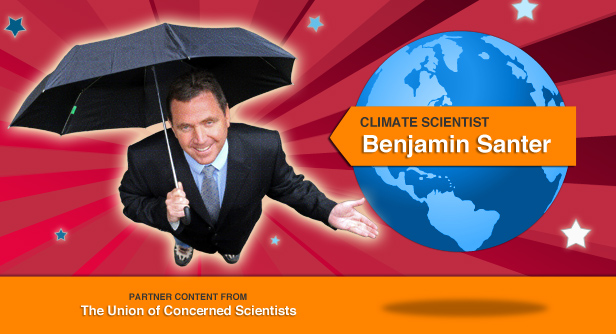So, how do we know that human byproducts — namely emissions from our tailpipes and smokestacks — are responsible for warming the planet? To Benjamin Santer, a climate scientist at the Lawrence Livermore National Laboratory in California, the answer is in the evidence.
Just as criminals leave fingerprints and DNA at the scene of a crime, climate change culprits leave distinct signatures or patterns that scientists can find — if they look closely enough. And hardly anyone has been looking longer or more carefully than Santer.

More than 23 years ago, just out of graduate school, Santer joined the Max Planck Institute for Meteorology in Germany. Through his work there with geophysicist Klaus Hasselmann, Santer became one of the first scientists in the world to begin to separate the signs of human influence on global climate from what he calls “the background noise of climate variability.”
Their research took advantage of early computer climate models which were generating a wealth of information about these human “fingerprints.” Scientists had documented for years that the average surface temperature of the planet was rising. But Santer and Hasselman began looking more closely at the geographical and altitudinal patterns of that warming.
The factors that might account for global warming — what climate scientists call “forcings” — operate in different ways. If Earth’s warming was caused by an increase in the sun’s energy output, explains Santer, “you would expect to see warming from the top of the atmospheric column straight down to the surface.” Warming caused by, say, massive volcanic eruptions would present a distinctly different profile.
The dust from volcanic eruptions can reach the upper portions of Earth’s atmosphere, and linger there for several years. Because volcanic dust absorbs sunlight, preventing its warmth from penetrating to the Earth’s surface, climate data would show cooling in the troposphere (the atmospheric layer closest to the Earth’s surface) and heating in the stratosphere (the layer above the troposphere).
But this pattern, says Santer, is “not at all what the data show.” His research, now replicated by many others, documents a telltale warming of the troposphere and a cooling of the stratosphere. This is the precise “greenhouse effect” fingerprint that scientists, since the 1960s, had predicted as increasing amounts of heat-trapping carbon dioxide from fossil-fuel emissions built up in the atmosphere.
Because of his groundbreaking work, Santer was selected as the lead author on a chapter of the 1995 report issued by the Intergovernmental Panel on Climate Change (IPCC). That year, for the first time, the report said that “the balance of evidence suggests a discernible human influence on global climate.” That measured statement has, of course, been dramatically strengthened in the latest IPCC report, which puts the likelihood that human activities have been the main cause of warming since the middle of the twentieth century at greater than 90 percent.
Santer’s research led to widespread acclaim from his colleagues and earned him many accolades, including a MacArthur Genius Grant. But his high-profile role in the 1995 IPCC report also made him a target. After the report was released, the Global Climate Coalition, an industry group funded mostly by oil companies, claimed Santer had altered the IPCC’s findings. He had not.
“Nothing in my university training prepared me for what I faced in the aftermath of that report,” Santer says. “You are prepared as a scientist to defend your research. But I was not prepared to defend my personal integrity. I never imagined I’d have to do that.”
Fifteen years later, the evidence that human activity is causing global warming is stronger than ever, and accepted by the overwhelming majority of scientists. Our understanding of climate fingerprinting has also become far more sophisticated and now shows human impact on changes in ocean temperatures, Arctic sea ice, precipitation, atmospheric moisture, and many other aspects of climate change.
Some of Santer’s more recent work, for instance, addresses changes in the height of the tropopause — the boundary between the troposphere, the more turbulent lower layer of Earth’s atmosphere, and the more stable stratosphere above. (Between 5 and 10 miles above the Earth’s surface, evidence of the tropopause can be seen in the flat, anvil-like top of a thundercloud.) Measurements over the course of several recent decades have shown that the tropopause has risen markedly. By studying tropopause changes in computer climate models, then comparing model output with actual observations, Santer was able to show that both the warming of the lower atmosphere and cooling of the stratosphere led to a rise in the height of the tropopause — and that the observed rise matched the fingerprint of an increase in heat-trapping gases. “Nobody had looked at it before,” Santer says. “But the data showed clearly that natural causes alone simply could not provide a convincing explanation for the observed change.”
All the climate fingerprinting research to date, has arrived at the same conclusion, says Santer; namely, that “natural causes cannot provide a convincing explanation for the particular patterns of climate change we see.” That, he says, is why scientists “have come to have such confidence in our understanding of what is happening — not because of the claims of any one individual, but because of the breadth of scientific work and reproducibility of the results.”
Despite the confidence of the scientific community, Santer is still regularly harassed by climate deniers. Soft-spoken, meticulous, and cautious by nature, he is an unlikely lightning rod, yet he often receives hate mail — and worse. Late one evening several years ago, he answered his doorbell to find a dead rat on the doorstep and a driver shouting curses from a Hummer that was zooming away down the street. Santer vented some frustration in private emails to former colleagues in the Climate Research Unit at the University of East Anglia in Britain. His emails, along with those from other scientists, were among the cache stolen and publicized in an effort to distract and mislead the public just before the 2009 climate summit in Copenhagen.
Santer knows a thing or two about tough spots. When he was 11-years-old, his father’s work for an international food service company took the family from suburban Maryland to Germany. Santer didn’t speak a word of German. His family enrolled him in a British army school, where he was the only kid who didn’t live on the military base or play soccer, and he had never even heard of cricket. He still remembers his teacher whacking him on the head with a rolled-up lesson book for writing in pencil instead of using the pen and inkwell on his desk as the European kids had been taught to do. “Let’s put it this way,” he says; “it was character-building.”
Today, Santer perseveres with much the same attitude. Unbowed by what he politely calls the “forces of unreason,” he continues to turn out world-class research and make himself available to speak about the scientific data on global warming. “I continue to believe that if the science is credible, people will do something about it,” he says. “Since my research is funded by the federal government, I’ve learned that my job is not just to do the best scientific research I can. I also have a responsibility to try to explain to people what it means, so an informed electorate can make good choices.”
This is the ninth installment of America’s Climate Scientists: A series from the Union of Concerned Scientists. Click here to read all the cl
imate scientist profiles.
The Union of Concerned Scientists is currently leading a campaign to elevate the voices of climate scientists and educate the public about the overwhelming scientific evidence for human-caused global warming. Learn how you can get involved at www.ucsusa.org/evidence.



